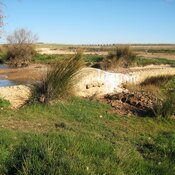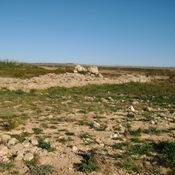http://www.patrimur.es/documents/1806272/1815089/memo15_18.pdf/ed8356c1-03bd-44d7-b744-dd94a2aeb334
SUPERVISIÓN ARQUEOLÓGICA DE LA RESTAURACIÓN DEL CASTILLO DE ALCALÁ DE LA PUEBLA DE MULA (MULA, MURCIA) RAFAEL GONZÁLEZ FERNÁNDEZ* FRANCISCO FERNÁNDEZ MATALLANA**
https://www.regmurcia.com/servlet/s.Sl?sit=c,522,m,166&r=CeAP-841-PORTADA_CENTRO_AMPLIADO
Castillo de Alcalá en Puebla de Mula - A comienzos del siglo VIII, Mula (un topónimo derivado de la palabra latina mola, que generó el castellano muela) era una de las poblaciones más importantes del sureste peninsular. Y así aparece en el conocido Pacto de Tudmir (Teodomiro), por el que los antiguos territorios visigodos situados en la cuenca del Segura pasaron a la órbita islámica. La antigua población de Mula, situada en el Cejo de la Almagra (cerca de los actuales Baños, según G. Matilla e I. Pelegrín), habría de aceptar, tras la firma de este tratado, un contingente militar de tropas musulmanas que quizá se asentó en el actual cerro donde hoy aparecen las ruinas del castillo de Alcalá.
Con el transcurrir de los siglos, tanto la fortaleza como la alquería que surgió a sus pies (quizá en la actual Puebla de Mula), fue adquiriendo importancia. Ya F. Amighes señaló que este castillo pudo ser una de las grandes fortalezas estatales que funcionaban como graneros dependientes del estado, donde eran custodiados los productos resultantes del cobro de impuestos. Ocupado por una guarnición militar castellana tras la incorporación del reino de Murcia a la Corona de Castilla a mediados del siglo XIII, aparece mencionado en la documentación generada durante la ocupación aragonesa de los territorios murcianos entre 1296 y 1305. Al parecer, continuó manteniendo Alcaide durante todo el siglo XIV. En 1373 el concejo de Mula vendió la propiedad de la fortaleza y de la pequeña aldea, quizá entonces casi despoblada, a Alonso Yáñez Fajardo. En 1380, los descendientes de éste emprendieron un intento de repoblación del lugar con mudéjares, que quisieron establecer con una conocida carta puebla.
-----
Castle of Alcalá in Mula - At the beginning of the 8th century, Mula (a toponym derived from the Latin word mola, which generated the Castilian muela) was one of the most important towns in the southeast of the peninsula. And so it appears in the well-known Pact of Tudmir (Teodomiro), by which the former Visigothic territories located in the Segura basin passed into the Islamic orbit. The ancient population of Mula, located in the Cejo de la Almagra (near the current Baños, according to G. Matilla and I. Pelegrín), would have to accept, after the signing of this treaty, a military contingent of Muslim troops that might be It settled on the current hill where the ruins of the castle of Alcalá appear today.
Over the centuries, both the fortress and the farmhouse that arose at its feet (perhaps in present-day Puebla de Mula), gained importance. Already F. Amighes pointed out that this castle could have been one of the great state fortresses that functioned as granaries dependent on the state, where the products resulting from the collection of taxes were guarded. Occupied by a Castilian military garrison after the incorporation of the kingdom of Murcia to the Crown of Castile in the mid-13th century, it appears mentioned in the documentation generated during the Aragonese occupation of the Murcian territories between 1296 and 1305. Apparently, it continued to maintain Alcaide during the entire fourteenth century. In 1373 the council of Mula sold the property of the fortress and the small village, perhaps then almost uninhabited, to Alonso Yáñez Fajardo. In 1380, his descendants undertook an attempt to repopulate the place with Mudejars, who wanted to establish it with a well-known Puebla charter.
-----
Château d'Alcalá à Mula - Au début du VIIIe siècle, Mula (un toponyme dérivé du mot latin mola, qui a engendré le castillan muela) était l'une des villes les plus importantes du sud-est de la péninsule. C'est ainsi qu'il apparaît dans le célèbre Pacte de Tudmir (Teodomiro), par lequel les anciens territoires wisigoths situés dans le bassin du Segura sont passés dans la sphère islamique. L'ancienne population de Mula, située dans le Cejo de la Almagra (près des Baños actuels, selon G. Matilla et I. Pelegrín), devrait accepter, après la signature de ce traité, un contingent militaire de troupes musulmanes qui pourraient be Il s'est installé sur la colline actuelle où apparaissent aujourd'hui les ruines du château d'Alcalá.
Au fil des siècles, la forteresse et la ferme qui s'élevait à ses pieds (peut-être dans l'actuelle Puebla de Mula) ont pris de l'importance. Déjà F. Amighes soulignait que ce château aurait pu être l'une des grandes forteresses d'État qui fonctionnaient comme des greniers dépendant de l'État, où étaient gardés les produits issus de la collecte des impôts. Occupé par une garnison militaire castillane après l'incorporation du royaume de Murcie à la couronne de Castille au milieu du XIIIe siècle, il apparaît mentionné dans la documentation générée lors de l'occupation aragonaise des territoires murciens entre 1296 et 1305. Apparemment, il a continué maintenir Alcaide pendant tout le XIVe siècle. En 1373, le conseil de Mula vendit la propriété de la forteresse et du petit village, peut-être alors presque inhabité, à Alonso Yáñez Fajardo. En 1380, ses descendants entreprirent une tentative de repeuplement de la place avec des mudéjars, qui voulaient l'établir avec une charte bien connue de Puebla.
-----
Замок Алькала в Муле - В начале 8 века Мула (топоним, происходящий от латинского слова mola, от которого произошло кастильское muela) был одним из самых важных городов на юго-востоке полуострова. Так оно и фигурирует в известном Тудмирском пакте (Теодомиро), по которому бывшие вестготские территории, расположенные в бассейне Сегуры, перешли в сферу ислама. Древнее население Мулы, расположенное в Сехо-де-ла-Альмагра (недалеко от нынешнего Баньоса, согласно Г. Матилле и И. Пелегрину), должно было после подписания этого договора принять военный контингент мусульманских войск, который мог Быть Он поселился на нынешнем холме, где сегодня появляются руины замка Алькала.
На протяжении веков и крепость, и фермерский дом, возникший у ее ног (возможно, в современном Пуэбла-де-Мула), приобрели значение. Уже Ф. Амиг указывал, что этот замок мог быть одной из великих государственных крепостей, функционировавших как зависимые от государства зернохранилища, где охранялись продукты, полученные в результате сбора налогов. Оккупированный кастильским военным гарнизоном после присоединения королевства Мерсия к короне Кастилии в середине 13 века, он упоминается в документах, созданных во время арагонской оккупации мурсийских территорий между 1296 и 1305 годами. поддерживать Алькаиду в течение всего четырнадцатого века. В 1373 году совет Мулы продал собственность крепости и небольшой деревни, возможно, тогда почти необитаемой, Алонсо Яньесу Фахардо. В 1380 году его потомки предприняли попытку заселить это место мудехарами, которые хотели основать его с помощью известной хартии Пуэблы.





































